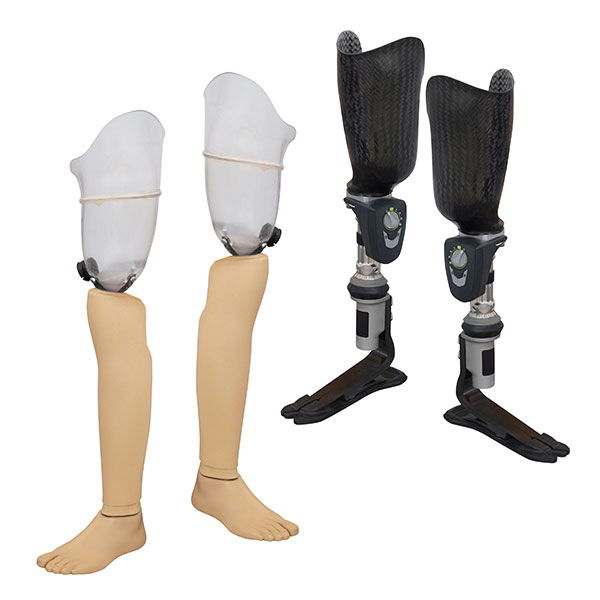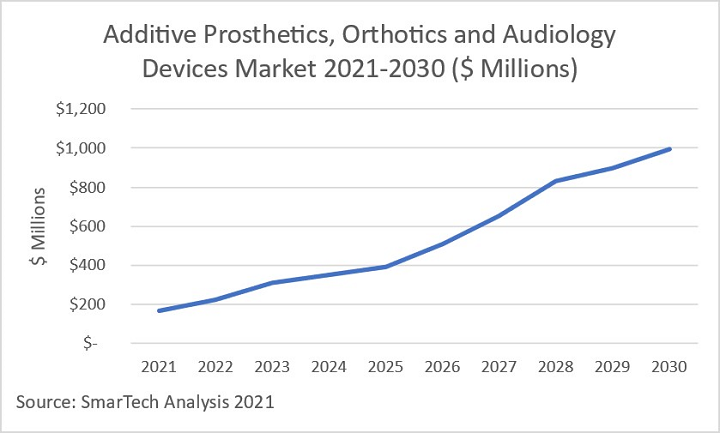Revenue from 3D Printed Prosthetics, Orthotics, & Audiology to Reach Nearly $1B by 2030, Says SmarTech Analysis
Top AM market research firm SmarTech Analysis has published a new report about the current and projected state of medical device 3D printing, specifically focusing on prosthetic, orthotic, and audiology devices. The technology is continuing to disrupt the medical device industry for various reasons, such as lower manufacturing costs, digitization, and at times even automation, and the ability to achieve greater levels of device customization. The report, “Medical Devices 2021: Market Opportunities for 3D Prosthetics, Orthotics and Audiology Devices,” projects that by the year 2026, this market will deliver $509 million in revenues, and will likely reach $996 million by 2030.
“This report explores the value propositions for 3D printing across the selected device segments, assessing the benefit, insertion points and stakeholder impact of technology adoption. Additionally, a review of the current state-of-the-art of 3D printing technologies in these areas showcases which technology solutions are positioned for future penetration. Finally, a ten year forecast for each device segment alongside technology adoption, material revenue and part printing forecasts provide a clear future outlook.”
Over the years, we’ve seen many examples of 3D printing become more established in fabricating medical devices like dental aligners and orthopaedic implants, as well as for surgical training and pre-surgical planning applications. In those case, the report discusses lower and upper limb prosthetics, orthotic braces and insoles, and hearing aid devices. While 3D printed O&P and audiology may not have the same media appeal, as they are non-surgical in nature, they’re easy to wear, which increases the patient’s comfort level. Additionally, they feature similar, approved design-to-manufacture supply chains, as well as similar product performance and requirements.
The market for 3D printed medical devices is quickly changing in key ways. For example, 3D printing in the orthotics and prosthetics industries is on the verge of leaving the R&D lab and moving into full-scale commercialization, and several prosthetic device and orthotic insole startups are starting to scale-up by partnering with industry stalwarts to develop and deliver customized corrective devices. Additionally, while 3D printing has been one of the established fabrication methods for hearing aid shells for several years, the potential is now increasing for 3D printed behind-the-ear devices. A major driver behind these increasing innovations? Customization.
 Renderings of a prosthetic limb which was 3D printed at Nebraska Innovation Studio and weighs less than an ounce. Image courtesy of University of Nebraska.
Renderings of a prosthetic limb which was 3D printed at Nebraska Innovation Studio and weighs less than an ounce. Image courtesy of University of Nebraska.“The most significant benefit of 3D printing to the medical device industry is the ability to customize products far more economically,” the SmarTech report states. “Product customization of 3D printed parts incurs minimal, if any, additional production cost. Within the healthcare industry, where every patient is unique, customization has a profound impact to improve the performance of medical devices, and in the near future, therapeutics.”
The SmarTech report takes a closer look at some of 3D printed medical device innovations created by many industry companies, including:
- 3D Systems
- Carbon
- Desktop Metal
- EnvisionTEC
- ExOne
- Formlabs
- FitMyFoot
- GE Additive
- Groupe Gorge/ Prodways
- HP
- Limbitless
- Materialise
- Naked Prosthetics
- Open Bionics
- Protolabs
- SLM Solutions
- Stratasys
- Stryker
- Ultimaker
- Twikit
- UNYQ
- Zimmer Biomet
Additionally, the report explains that applications for medical modeling continue to increase beyond merely training and educational purposes. For instance, 3D diagnostic processes, like CT and MRI scanning, can be used to create 3D printed anatomical models so surgeons can better explain complex procedures to patients and their families, while also using them for pre-surgical planning in order to lower the risk to the patient.
For additive manufacturing trends within the prosthetic, orthotic and audiology market, the potential for supply chain reconfiguration, value propositions, improved customer engagement through 3D printing, and more, you can request an excerpt, or purchase the entire “Medical Devices 2021: Market Opportunities for 3D Prosthetics, Orthotics and Audiology Devices” report by SmarTech Analysis here, or you can contact info@smartechpublishing.com.
Subscribe to Our Email Newsletter
Stay up-to-date on all the latest news from the 3D printing industry and receive information and offers from third party vendors.
You May Also Like
3D Printing News Briefs, April 13, 2024: Robotics, Orthotics, & Hypersonics
In 3D Printing News Briefs today, we’re focusing first on robotics, as Carnegie Mellon University’s new Robotics Innovation Center will house several community outreach programs, and Ugogo3D is now working...
Rail Giant Alstom Saves $15M with 3D Printing Automation Software 3D Spark
3D Spark has entered into a three-year deal with the rail giant Alstom. Alstom, a transport behemoth with annual revenues of $16 billion, specializes in the manufacture of trains, trams,...
Meltio Expands Global Reach with New Partnerships in the Americas and Europe
Spanish 3D printing manufacturer Meltio has expanded its sales network across the globe. With the addition of three new partners in the United States, Brazil, Argentina, and Italy, Meltio aims...
3D Printing Webinar and Event Roundup: April 7, 2024
Webinars and events in the 3D printing industry are picking back up this week! Sea-Air-Space is coming to Maryland, and SAE International is sponsoring a 3D Systems webinar about 3D...

































